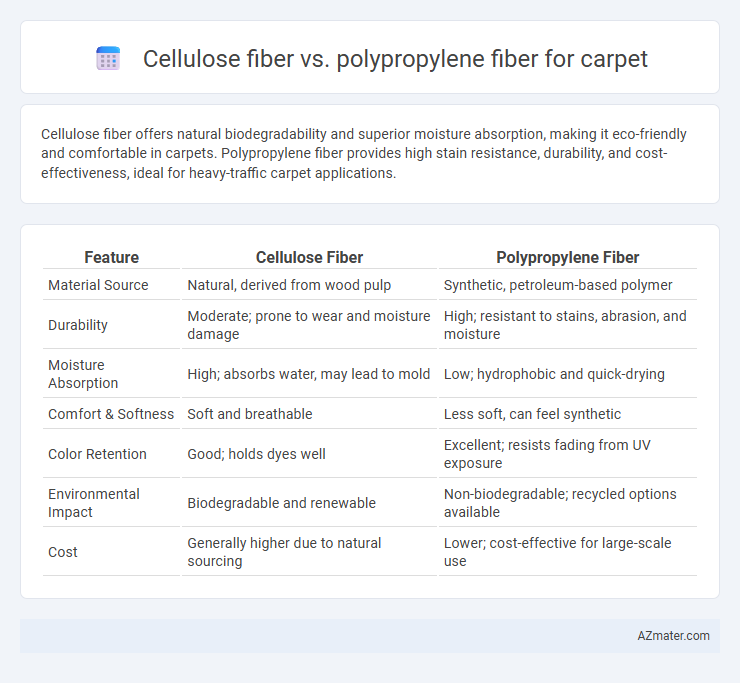Cellulose fiber offers natural biodegradability and superior moisture absorption, making it eco-friendly and comfortable in carpets. Polypropylene fiber provides high stain resistance, durability, and cost-effectiveness, ideal for heavy-traffic carpet applications.
Table of Comparison
| Feature | Cellulose Fiber | Polypropylene Fiber |
|---|---|---|
| Material Source | Natural, derived from wood pulp | Synthetic, petroleum-based polymer |
| Durability | Moderate; prone to wear and moisture damage | High; resistant to stains, abrasion, and moisture |
| Moisture Absorption | High; absorbs water, may lead to mold | Low; hydrophobic and quick-drying |
| Comfort & Softness | Soft and breathable | Less soft, can feel synthetic |
| Color Retention | Good; holds dyes well | Excellent; resists fading from UV exposure |
| Environmental Impact | Biodegradable and renewable | Non-biodegradable; recycled options available |
| Cost | Generally higher due to natural sourcing | Lower; cost-effective for large-scale use |
Introduction to Carpet Fiber Types
Carpet fibers are primarily composed of natural and synthetic materials, with cellulose fiber representing a natural option derived from plant-based sources, known for its eco-friendliness and biodegradability. Polypropylene fiber, a synthetic polymer, offers excellent stain resistance, durability, and affordability, making it one of the most popular choices for residential and commercial carpets. Understanding the characteristics of cellulose versus polypropylene fibers is crucial for selecting the appropriate carpet fiber based on factors such as texture, maintenance, environmental impact, and cost.
Overview of Cellulose Fiber Carpets
Cellulose fiber carpets, derived from natural plant materials such as wood pulp or cotton linters, offer superior biodegradability and moisture absorption compared to polypropylene fibers. These carpets provide enhanced comfort and breathability while supporting sustainable and eco-friendly flooring solutions. Their natural origin and ability to retain dye well result in vibrant colors and an appealing texture that stands out in interior design.
Overview of Polypropylene Fiber Carpets
Polypropylene fiber carpets are highly valued for their stain resistance, moisture repellence, and affordability, making them ideal for high-traffic areas and households with pets or children. Unlike cellulose fibers, polypropylene offers superior durability and colorfastness due to its synthetic nature and hydrophobic properties. Its lightweight structure enhances ease of installation and maintenance, contributing to its widespread use in both residential and commercial carpeting solutions.
Durability: Cellulose vs Polypropylene
Polypropylene fiber exhibits superior durability compared to cellulose fiber in carpet applications due to its resistance to moisture, stains, and abrasion. Cellulose fiber, derived from natural sources like wood pulp, tends to absorb moisture, leading to quicker wear and potential degradation under heavy foot traffic. The hydrophobic nature and chemical stability of polypropylene contribute to longer-lasting carpets, making it a preferred choice for high-traffic and commercial environments.
Stain Resistance Comparison
Polypropylene fiber offers superior stain resistance compared to cellulose fiber in carpet applications due to its hydrophobic nature and low moisture absorption, which prevents liquids and dirt from penetrating the fibers. Cellulose fiber, being more absorbent, tends to retain stains and requires more frequent cleaning and maintenance. As a result, polypropylene fiber is preferred for high-traffic areas where stain resistance and easy maintenance are critical.
Comfort and Texture Differences
Cellulose fiber carpets offer superior softness and a natural, breathable texture that enhances comfort underfoot, making them ideal for residential settings. Polypropylene fiber, while more durable and stain-resistant, tends to have a coarser feel and lacks the plushness found in cellulose fibers. The natural moisture-wicking properties of cellulose fibers contribute to a cooler, more comfortable carpet experience compared to the synthetic, less breathable texture of polypropylene.
Environmental Impact of Each Fiber
Cellulose fiber, derived from plant sources such as wood pulp or cotton, offers biodegradability and renewable origin, significantly reducing long-term environmental impact compared to synthetic fibers. Polypropylene fiber, a petroleum-based synthetic, poses environmental challenges due to its non-biodegradable nature and reliance on fossil fuels, leading to persistent microplastic pollution and higher carbon emissions. Choosing cellulose fiber for carpets supports reduced landfill waste and lower carbon footprints, aligning with sustainable material practices.
Cost Considerations for Buyers
Cellulose fibers generally offer a lower upfront cost compared to polypropylene fibers, making them an attractive option for budget-conscious carpet buyers. Polypropylene fibers, while more expensive initially, provide superior durability and resistance to stains, potentially reducing replacement and maintenance costs over time. Buyers should weigh the immediate cost savings of cellulose against the long-term value and performance benefits of polypropylene when selecting carpet materials.
Maintenance and Cleaning Requirements
Cellulose fiber carpets require more frequent cleaning due to their higher absorbency, making them prone to staining and moisture retention, which can lead to mold growth if not properly maintained. Polypropylene fiber carpets, being hydrophobic and stain-resistant, demand less intensive cleaning and are easier to maintain with regular vacuuming and occasional stain treatment. The durability of polypropylene fibers also contributes to longer intervals between deep cleanings compared to cellulose fiber carpets.
Choosing the Right Fiber for Your Carpet Needs
Cellulose fiber offers natural breathability, moisture-wicking properties, and eco-friendly benefits, making it ideal for carpets in humid or indoor environments. Polypropylene fiber excels in stain resistance, durability, and affordability, suitable for high-traffic areas and outdoor use. Selecting the right fiber depends on factors like carpet location, expected wear, maintenance preferences, and environmental considerations.

Infographic: Cellulose fiber vs Polypropylene fiber for Carpet
 azmater.com
azmater.com